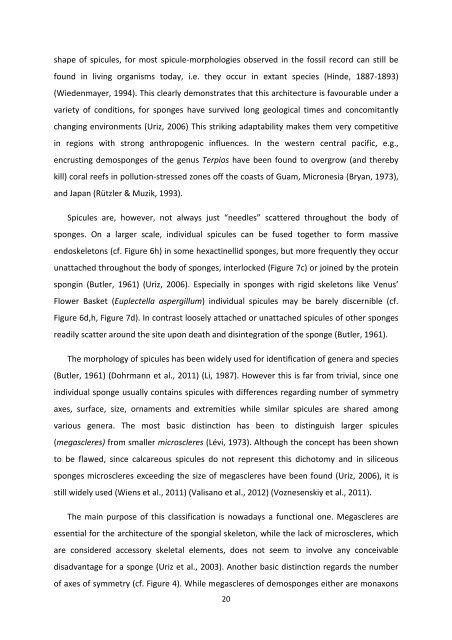MASTER THESIS Biomimetic potential of sponge ... - IAP/TU Wien
MASTER THESIS Biomimetic potential of sponge ... - IAP/TU Wien
MASTER THESIS Biomimetic potential of sponge ... - IAP/TU Wien
Create successful ePaper yourself
Turn your PDF publications into a flip-book with our unique Google optimized e-Paper software.
shape <strong>of</strong> spicules, for most spicule-morphologies observed in the fossil record can still be<br />
found in living organisms today, i.e. they occur in extant species (Hinde, 1887-1893)<br />
(Wiedenmayer, 1994). This clearly demonstrates that this architecture is favourable under a<br />
variety <strong>of</strong> conditions, for <strong>sponge</strong>s have survived long geological times and concomitantly<br />
changing environments (Uriz, 2006) This striking adaptability makes them very competitive<br />
in regions with strong anthropogenic influences. In the western central pacific, e.g.,<br />
encrusting demo<strong>sponge</strong>s <strong>of</strong> the genus Terpios have been found to overgrow (and thereby<br />
kill) coral reefs in pollution-stressed zones <strong>of</strong>f the coasts <strong>of</strong> Guam, Micronesia (Bryan, 1973),<br />
and Japan (Rützler & Muzik, 1993).<br />
Spicules are, however, not always just “needles” scattered throughout the body <strong>of</strong><br />
<strong>sponge</strong>s. On a larger scale, individual spicules can be fused together to form massive<br />
endoskeletons (cf. Figure 6h) in some hexactinellid <strong>sponge</strong>s, but more frequently they occur<br />
unattached throughout the body <strong>of</strong> <strong>sponge</strong>s, interlocked (Figure 7c) or joined by the protein<br />
spongin (Butler, 1961) (Uriz, 2006). Especially in <strong>sponge</strong>s with rigid skeletons like Venus’<br />
Flower Basket (Euplectella aspergillum) individual spicules may be barely discernible (cf.<br />
Figure 6d,h, Figure 7d). In contrast loosely attached or unattached spicules <strong>of</strong> other <strong>sponge</strong>s<br />
readily scatter around the site upon death and disintegration <strong>of</strong> the <strong>sponge</strong> (Butler, 1961).<br />
The morphology <strong>of</strong> spicules has been widely used for identification <strong>of</strong> genera and species<br />
(Butler, 1961) (Dohrmann et al., 2011) (Li, 1987). However this is far from trivial, since one<br />
individual <strong>sponge</strong> usually contains spicules with differences regarding number <strong>of</strong> symmetry<br />
axes, surface, size, ornaments and extremities while similar spicules are shared among<br />
various genera. The most basic distinction has been to distinguish larger spicules<br />
(megascleres) from smaller microscleres (Lévi, 1973). Although the concept has been shown<br />
to be flawed, since calcareous spicules do not represent this dichotomy and in siliceous<br />
<strong>sponge</strong>s microscleres exceeding the size <strong>of</strong> megascleres have been found (Uriz, 2006), it is<br />
still widely used (<strong>Wien</strong>s et al., 2011) (Valisano et al., 2012) (Voznesenskiy et al., 2011).<br />
The main purpose <strong>of</strong> this classification is nowadays a functional one. Megascleres are<br />
essential for the architecture <strong>of</strong> the spongial skeleton, while the lack <strong>of</strong> microscleres, which<br />
are considered accessory skeletal elements, does not seem to involve any conceivable<br />
disadvantage for a <strong>sponge</strong> (Uriz et al., 2003). Another basic distinction regards the number<br />
<strong>of</strong> axes <strong>of</strong> symmetry (cf. Figure 4). While megascleres <strong>of</strong> demo<strong>sponge</strong>s either are monaxons<br />
20

















